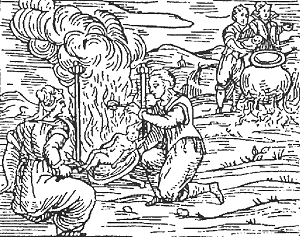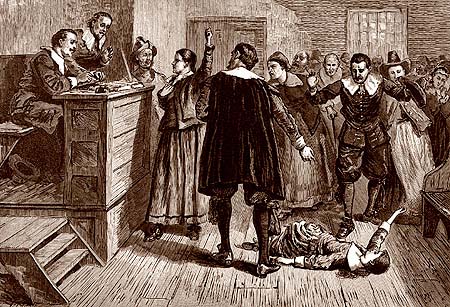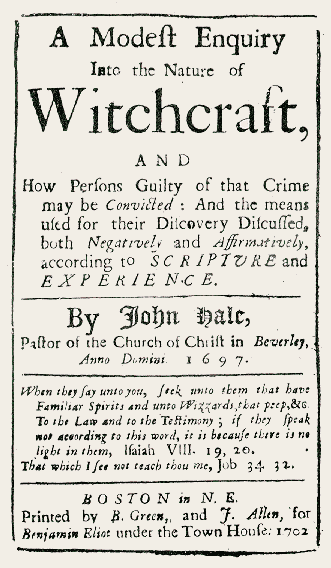|
Rotten Library > The Occult > Witchcraft
Witchcraft The history of witchcraft is as old as the history of humanity, long and rich enough to fill several books and as complex as the human soul itself. In light of this, it's best to approach the topic here as fodder for a series of entertaining anecdotes which utterly fail to enlighten or inspire. Fortunately, there is no shortage of lurid tales of well-endowed incubus encounters with busty free-spirit earth goddesses to support such a quest.
The history of witchcraft is as old as the history of humanity, long and rich enough to fill several books and as complex as the human soul itself. In light of this, it's best to approach the topic here as fodder for a series of entertaining anecdotes which utterly fail to enlighten or inspire. Fortunately, there is no shortage of lurid tales of well-endowed incubus encounters with busty free-spirit earth goddesses to support such a quest. But first, a good faith effort to actually describe the import of witchcraft to society. Basically, humans have eternally sought to define their relationship with nature in one of two ways -- harmony or conquest. Witchcraft is a collection of wildly divergent traditions for accomplishing one of those goals. The first witches were the primary healthcare providers for ancient peoples, with several traditions focusing on herbs and medicinal plants. In the process of researching such plants, witches discovered that some plants, when ingested, made you see really wild stuff. That led to shamanism, in which the witch communes with the divine in very particular ways. The evolution of these roles went side-by-side with the evolution of magic, or "magick" as Aleister Crowley called it, in order to distinguish from the stagecraft magic involving rabbits and hats. Arthur C. Clarke, author of 2001: A Space Odyssey, once famously remarked that "any sufficiently advanced technology is indistinguishable from magic." In primitive times, pretty much everything was indistinguishable from magick. Since witches and shamans were the keepers of magick, that gave them a lot of power. The earliest practices of witchcraft included communication with the dead, communication with spirits, weather manipulation and various medical pursuits. And of course, the cursing and hexing. As villages grew into cities, a new kind of power began to emerge -- political power. Witches and shamans tended to be iconoclastic sorts, misfits, even sometimes mentally deranged from ingesting all those plants. That made them unsuitable tools for kings seeking to control the masses, so politicians invented Religion, which quickly became the mortal enemy of witchcraft. There were as many forms of witchcraft as there were villages at the time. Primitive witches worked with animistic spirits and a host of minor deities, whom they beseeched for help. As religions began to take precedence, these spirits were classified and reclassified as "good" and "evil" according to which served the king's purposes. The witch wars would persist throughout the remainder of human history, and the concept of harmony increasingly gave way to conquest as a result, essentially drawing a sharp line of demarcation between those who sought power over people and institutions and those who sought power over the elements and individuals. Perhaps the most famous witch of early civilization was Aaron, the brother of Moses, who engaged in a sorcerous war against the Pharoah of Egypt, flinging enough curses and hexes to warm an Inquisitor's heart. Using a magic staff, they inflicted frogs and locusts on the people of Egypt. turned the Nile blood red and eventually summoned an otherworldly creature to slaughter the Egyptians' firstborn sons. Ironically, it was Moses who caused the greatest problems for later witches with a statement of Jewish law, "Thou shalt not suffer a witch to live", which would become the rallying cry of later persecutions. Although there are strong legitimate historical currents tying witchcraft and sexuality, the really lurid tales of debauchery and diablophilia were largely concocted by the warped minds of the witch hunters, including the Inquisition and later the Puritans.
With its internal enemies reclassified as "schisms" instead of "heresies", which apparently represented some sort of moral victory, the Church turned to external foes. These included the Knights Templar, the Cathars, and witches. When the Catholics moved into an area, they took one of two approaches to dealing with local pagan practices -- either they co-opted them into the Church, or they demonized them to extreme levels. So while Ireland's St. Patrick got a warm welcome into Catholic mythology, the local wise women were not so fortunate. Celtic pagan legends of the Green Man of the Forest were subverted into the Dark Man, a horned and tailed figure whose prodigious penis spewed the devil's jizz all over eager and wanton women as an initiation into the Dark Arts. Pope Innocent VIII was appalled to hear of these things, sorrowfully reporting in a papal bull that "many persons of both sexes, heedless of their own salvation and forsaking the catholic faith, give themselves over to devils male and female, and by their incantations, charms, and conjurings, and by other abominable superstitions and sortileges, offences, crimes, and misdeeds [...]" Innocent was so distraught by these charges that he ordered the Inquisition to bring out the comfy chairs. A charge of witchcraft was a pretty excellent way to get rid of someone you didn't like, since it was difficult to defend against. As a climate of fear deepened around the Inquisitors, accused witches were ignored if they denied the charges and rewarded if they named names, which predictably led to a rapid escalation of Witch Trials and the burning of many people at the stake. The inquisitors had rather lurid imaginations, and they wrote endless treatises on the evils of witchcraft, the ceremonies they imagined witches took part in, the signs of witchiness and the appropriate tortures for accused witches.
Now the wickedness of women is spoken of in Ecclesiasticus xxv: There is no head above the head of a serpent: and there is no wrath above the wrath of a woman. I had rather dwell with a lion and a dragon than to keep house with a wicked woman. And among much which in that place precedes and follows about a wicked woman, he concludes: All wickedness is but little to the wickedness of a woman. Wherefore S. John Chrysostom says on the text, It is not good to marry: What else is woman but a foe to friendship, an unescapable punishment, a necessary evil, a natural temptation, a desirable calamity, a domestic danger, a delectable detriment, an evil of nature, painted with fair colours! Therefore if it be a sin to divorce her when she ought to be kept, it is indeed a necessary torture; for either we commit adultery by divorcing her, or we must endure daily strife. Cicero in his second book of The Rhetorics says: The many lusts of men lead them into one sin, but the lust of women leads them into all sins; for the root of all woman's vices is avarice. And Seneca says in his Tragedies: A woman either loves or hates; there is no third grade. And the tears of woman are a deception, for they may spring from true grief, or they may be a snare. When a woman thinks alone, she thinks evil. Charming, eh? Or the following:
With regard to the bewitchment of human beings by means of Incubus and Succubus devils, it is to be noted that this can happen in three ways. First, when women voluntarily prostitute themselves to Incubus devils. Secondly, when men have connexion with Succubus devils; yet it does not appear that men thus devilishly fornicate with the same full degree of culpability; for men, being by nature intellectually stronger than women, are more apt to abhor such practises.
The method of beginning an examination by torture is as follows: First, the jailers prepare the implements of torture, then they strip the prisoner (if it be a woman, she has already been stripped by other women, upright and of good report). This stripping is lest some means of witchcraft may have been sewed into the clothing-such as often, taught by the Devil, they prepare from the bodies of unbaptized infants, [murdered] that they may forfeit salvation. And when the implements of torture have been prepared, the judge, both in person and through other good men zealous in the faith, tries to persuade the prisoner to confess the truth freely; but, if he will not confess, he bid attendants make the prisoner fast to the strappado or some other implement of torture. The attendants obey forthwith, yet with feigned agitation. Then, at the prayer of some of those present, the prisoner is loosed again and is taken aside and once more persuaded to confess, being led to believe that he will in that case not be put to death. The persecution of women who may or may not have been witches is known to modern-day New Age reconstructionists as "The Burning Times", logically enough, since witches were customarily burned at the stake. The phrase is now bandied about both as a feminist credo as well a battle cry ("Never again the Burning Times!") among young upper-middle-class Neopagans who apparently somehow feel they are in imminent peril of being burned themselves. The persecution of witches carried over into the New World when the hideously twisted Puritans adopted witch-hunting as an outlet for the basic sexual urges which they repressed to an absurd degree. The Puritans and especially their New England settlements became synonymous with the Witch Trials, an American inquisition which saw women dragged before tribunals, maligned and frequently executed.
Gardner was an upper-middle class British male who saw no contradiction in claiming to be heir to a legacy of female-empowering Celtic witch tradition. Gardner claimed to have discovered a surviving remnant of "Wicca." According to Gardner, Wicca was an "ancient religion" whose priestesses were witches. A former Mason, he naturally claimed that he had been exclusively initiated into the ways of Wicca and he drove a "revival" of the "Old Ways" in 20th Century England. You may have noticed an overabundance of quotation marks in the preceding passage. Gardner's claims are not without controversy. Many people have noted the dearth of historical evidence to support Gardner's Wicca theory, and some have also noted the similarities of certain practices, beliefs and texts to Aleister Crowley's neopagan religion of Thelema (the two were friends). In short, a lot of people think he made the whole thing up, but Wicca is at least partly based on traditional witchcraft practices, leavened with a healthy dose of Masonic trappings. Wiccans approached witchcraft from the angle of making it so incredibly harmless that no one would want to burn them. They get cranky if you mention hexes or curses, and many are fiercely proprietary about the word "witch". Wicca caught on in the U.S. during the 1960s as an adjunct to the feminist revolution. There are something like hundreds of thousands of Wiccans in the U.S. and more worldwide, but it's difficult to estimate numbers because many adherents have stayed "in the broom closet" for fear of being burned, discriminated against or even -- gasp -- becoming the object of mild derision.
|
 The first aggressive campaigns to eradicate witchcraft began when the Catholic Church rose to political power. For a religion based on love and meekness, the Catholics were beset by internecine battles from the very beginning. After a campaign to wipe out
The first aggressive campaigns to eradicate witchcraft began when the Catholic Church rose to political power. For a religion based on love and meekness, the Catholics were beset by internecine battles from the very beginning. After a campaign to wipe out  The perils of witchcraft were spelled out most famously in the Malleus Maleficarum, an infamous 15th century manual for witch hunters that has become a historical watershed of misogynistic excess. For instance, the book attempts to answer the question of why women are witches instead of men:
The perils of witchcraft were spelled out most famously in the Malleus Maleficarum, an infamous 15th century manual for witch hunters that has become a historical watershed of misogynistic excess. For instance, the book attempts to answer the question of why women are witches instead of men:  So you see, when women commit sexual excesses with demons, they are prostitute-witches. When men do the same, they are the victims of prostitute-witches. Men and women alike were eligible to end up on the receiving end of the Inquisitor's charms, however. The book outlines the starting procedure for eliciting a confession:
So you see, when women commit sexual excesses with demons, they are prostitute-witches. When men do the same, they are the victims of prostitute-witches. Men and women alike were eligible to end up on the receiving end of the Inquisitor's charms, however. The book outlines the starting procedure for eliciting a confession:
 While the Puritans chased phantoms, using witchcraft as a flimsy excuse to punish women for voluptuously tempting their pathetic lusts, the actual practice of magic went entirely underground, persisting in local practices, small gatherings known as covens, and in family traditions. It emerged in force once again in the 20th century, spearheaded by a man named Gerald Gardner.
While the Puritans chased phantoms, using witchcraft as a flimsy excuse to punish women for voluptuously tempting their pathetic lusts, the actual practice of magic went entirely underground, persisting in local practices, small gatherings known as covens, and in family traditions. It emerged in force once again in the 20th century, spearheaded by a man named Gerald Gardner.